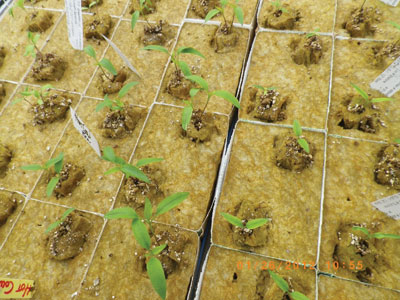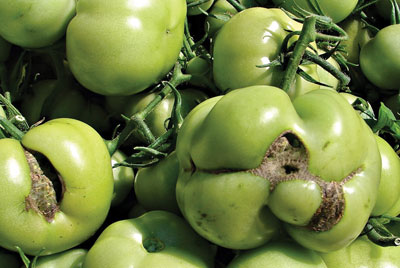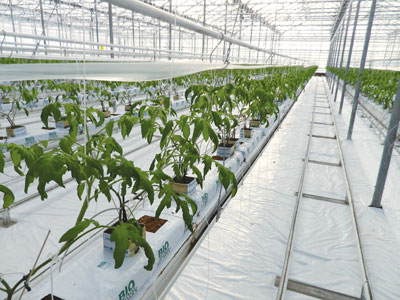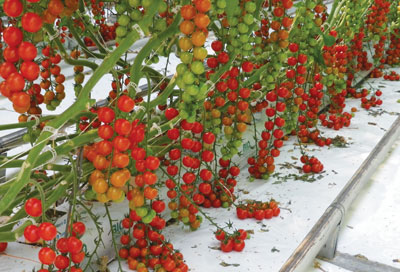
Features
Crop Culture
Inputs
Growing Points: Getting off to a good start
December 20, 2012 By Dr. Mohyuddin Mirza
January is the month when many vegetable growers start their crops.
January is the month when many vegetable growers start their crops. I have seen different patterns for seedling production.
Many growers in Alberta order their cucumber, tomato and pepper seedlings from commercial propagators in British Columbia. Ontario has its own capacity to supply good quality seedlings.
There are still a number of growers who grow their own seedlings using supplemental lights. I know owners of smaller greenhouses who grow seedlings in their basements using lights, and who also partition the greenhouse and put a few lights in there!
The overall trend is to bring in good quality seedlings of the age you want. For example, tomato growers prefer 30-day-old seedlings, pepper growers bring in 40-day-old seedlings, and cucumber growers bring in 21-day-old seedlings. This saves times on starting the crops and good quality can be assured.
I remember a study our team did few years ago where we proved that poor looking and smaller seedlings never caught up to the production potential achieved by good quality seedlings.

|
|
Rockwool is the most commonly used medium for seedling propagation. Seeding is done in two-inch propagation cubes and then transplanted into bigger rockwool blocks. The use of a thermometer in the blocks emphasizes the temperature required inside the growing medium.
There is still some production in five-inch pots using a soilless medium for planting into peat bags. I think the real starting point is the choice of varieties, which is done several months before seeding. The choice of varieties is based on your own experience and what the market dictates.
CHOOSE YOUR VARIETIES CAREFULLY
■ There is so much information available now on selection of varieties. In the case of cucumbers there are varieties available for early/spring, summer and autumn, and for artificial lighting.
Cucumbers are grown three to four times per year. This has been a gradual progression. I remember a time when the standard was two crops per year, and then we adopted a three-crop system. Some growers are now up to four crops a year. Select varieties accordingly based on your climate and whether you are using lights under low-light conditions.
Tomatoes and peppers are grown as one crop per year, so you have to select many varieties based on colour, size and taste. In many cases, growers don’t pay enough attention to disease resistance and sometimes notations on variety descriptions have to be traced as to what they mean.
When I was looking for some varieties, I saw a good description of a particular cucumber variety by one company. Most of the time it is fairly generic information, because it is difficult to give exact specifications.
“It produces superior yields of medium-sized cucumbers for high-light growing periods. It is heat tolerant and has high resistance to powdery mildew and key viruses, plus horizontal resistance to CGMMV. High production of medium-sized, long, straight fruit primarily in the 30.5 to 35.6 cm (12- to 14-inch) range. Very attractive fruit with dark green colour, smooth skin and good ribbing throughout crop. Very successful for active greenhouse production, and a strong performer in both umbrella and high-wire cropping systems. A great choice for warmer production times. Works well for lit crops. High packouts of medium-sized fruit with desired fresh-market qualities. Lowers production risks during high heat and humidity when powdery mildew is more problematic.”
LABELS OFTEN LIST DISEASE RESISTANCE
■ I did not initially understand the “resistance to CGMMV” notation, but later learned it stands for Cucumber Green Mottle Mosaic Virus. Many other examples of disease resistance are also provided. It’s important, then, to be familiar with notations like ToMV (Tomato Mosaic Virus), ToANV (Tomato Apex Necrotic Virus), Ff (Leaf mould Fulvia fulva) and FoI (Fusarium wilt). There are many other fusarium related diseases.
I was not sure about “horizontal resistance,” and learned there are two types of disease resistance in genetic breeding. One is vertical resistance, which is controlled by a single gene; the other is horizontal resistance, which is controlled by many genes. Growers must be aware of all the common diseases in their area and choose varieties accordingly.
EARLY MANAGEMENT OF SEEDLINGS
■ Good quality seedlings are essential in laying the foundation of the entire crop.
Let’s look at tomato seedlings. Let us say that you bring in 30-day-old seedlings. Based on how they were grown in terms of light and temperature, the first cluster may be visible as buds set, but the first three trusses have been initiated in the growing point. Once the first truss is flowering, five trusses have been initiated. By the first truss harvesting, 10 to 12 trusses have been initiated.
Thus, it’s important to know how the seedlings were grown. Ask about the temperature and light conditions under which the seedlings were grown. If at the time of very first bud set the temperature was cool, that is, around 12-14ºC, then expect to have rough fruit.

|
This is commonly referred to as “catfacing.” The fruit on the entire cluster can be rendered unsalable and thus an economic loss can occur.
One of the most commonly asked questions is how to keep a balance between vegetative and generative growth in January when no supplemental light is used.
I have seen good quality tomato seedlings stretch so much that the first cluster appears to be very high on the plant. This happens when light is low and the 24-hour average temperature is higher than 21ºC. The limited amount of food produced is used up to make more leaves, which are thin, and the plant appears to be leggy.
So, bring the 24-hour average temperature below 20ºC.
Another important management strategy is to let the seedlings stay on the plastic; don’t put them into the bags until the first cluster is fully open. That is what this grower (next photo) was doing. You can see that the seedlings are not in the hole.

|
|
Another important management tool is to use higher electrical conductivity (EC) fertilizer solution. Under January light conditions in Canada, we can use EC as high as 6.0 millimhos/cm. This will create osmotic pressure in the rootzone and the plant will not be able to utilize much water. Spindly growth can now be avoided.
My suggestion is to use potassium sulphate (0-0-52) for this purpose. Many growers use sodium chloride or potassium chloride, as well.
By using higher EC and keeping day and night temperatures as close as possible, the plant will stay compact, it will be good, dark green in colour, and there will be balanced growth.

|
|
Attention to these details will set the foundation for a great crop. In May, your crop should look like this (above photo)!
If you find that first cluster on a tomato seedling is long and has very big flowers, I would recommend removing the entire cluster. This will help the plant establish more roots and improve the balance between vegetative and generative growth.
Dr. Mohyuddin Mirza is a greenhouse consultant. • drmirzaconsultants@gmail.com
Print this page